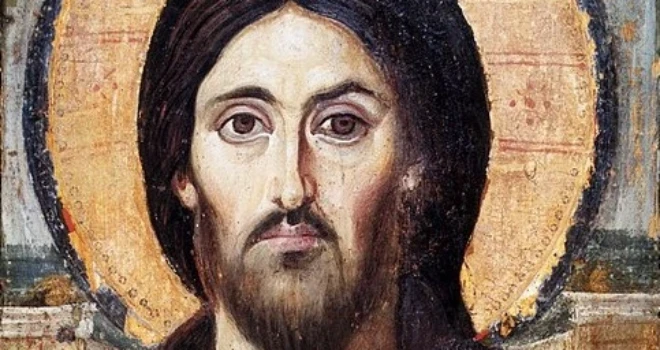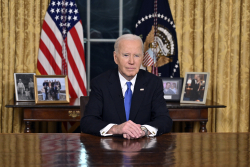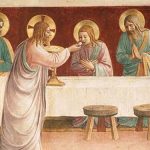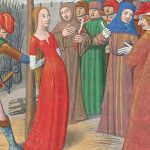The Feast of Corpus Christi, celebrating the Eucharist as the true Body, Blood, Soul, and Divinity of Christ, invites profound reflection on the sanctity of life, especially in light of contemporary discussions surrounding abortion, what many call the “anti-sacrament” of what we consider the “source and summit” of the spiritual life of the Church (Lumen Gentium 11). Talking about the Eucharist while talking about abortion is not without its logic because we are really in the midst of a war between the Sacrament par excellence of the Church and the anti-sacrament par excellence of those formally against the Church, against the Mystical Body of Christ.
If we think about it, there is a common thread in recent major liturgical celebrations. The very Ascension of Our Lord recalls how Christ was sent on a mission when He assumed our nature in the mystery of the Incarnation only to conclude it with His ascent back to the Father, after completing the mission.
This is why it says: “When he ascended on high, he took many captives and gave gifts to his people.” What does ‘he ascended’ mean except that he also descended to the lower, earthly regions? He who descended is the very one who ascended higher than all the heavens, in order to fill the whole universe. (Eph. 4:8-10)
This passage highlights both the descent of Christ to the earthly realm and His subsequent ascent into heaven, emphasizing His authority and role in salvation. The Paschal mystery itself has closure with the Ascension. That is why the Easter Candle is no longer used after the Ascension in the Eucharist, except for Baptisms. After all, to rise from the dead to remain in a merely natural existence is not what brings us hope. The elevation above what is merely human, while not excluding our humanity, is the message of hope in the eternal life. Once Christ wins over death, this has to have meaning beyond natural life. Eternal life is not about infinite years of earthly life, the way Condorcet or other space-traveling sci-fi dreamers would have it. There is something more to redemption. This is why the very body of the Resurrected Lord is different. Noli me tangere, He tells St. Mary Magdalene. It is a glorified body pointing to our end: the Glory of God.
Like one cannot forget the Ascension in light of the Paschal Mystery, one cannot forget it in light of the Pentecost Mystery. Christ ascends because He descended, St. Paul reminds us. This is the famous exitus et reditus of neoplatonic thought common to a divine mission. The will of the Son is united to that of the Father, and the will of Christ is one in which there is harmony between the human and divine natures. This is where sanctification points: to do the will of God. This harmonious union between the human and divine wills is key to Christ as Mediator, a perfect bridge between us and God. We cannot forget this bridge. If we forget it, we are simply spiritualists, Gnostics, dualists.
However, how is this harmonious union between our wills and that of the Father possible for us? It is possible because we receive the Spirit of the Father and the Son (Rom. 8:15 and 1 Jn. 4:13). We no longer live only by our rational soul (the psychological man) but by the Spirit that was poured unto us, elevating us to the spiritual man, as St. Paul teaches (1 Cor. 15:40-44), i.e. the man who lives in the Spirit of the Father and the Son—Dominum et Vivificantem, “Lord and life-giver”—sanctified, brought to the likeness of God by His Spirit. The mediation between Christ and us is “bi-directional”: through Christ, man’s nature is elevated to God the Father in the Ascension, and through Him, the Spirit comes from the Father unto each of us. All we must do is collaborate with this amazing grace, this amazing Holy Spirit who “inhabits within us” (cf. 1 Cor. 6:19-20).
So, we come to Corpus Christi—immediately after the Feast of the Holy Trinity, which reminds us of the inner life of God Himself, and after Pentecost, which reminds us of the Mission of the Holy Spirit who works within us, members of the Church, members of the Mystical Body of Christ, the inner workings of divine life. Our Faith is not just about external acts of religion but about the interior law, the law of the conversion of the heart which is manifest on the Cross and represented at each Mass. So, the prophet Ezekiel writes on what Christ, Priest, Prophet, and King would do:
I will give you a new heart and put a new spirit in you; I will remove from you your heart of stone and give you a heart of flesh. And I will put my Spirit in you and move you to follow my decrees and be careful to keep my laws. (Ezek. 36:26-27)
This passage beautifully expresses the promise of transformation and renewal of the heart, highlighting God’s intention to transform the hearts of His people, replacing their stubbornness with a responsive and tender heart, empowered by His Spirit. It is a powerful message of hope and renewal. But where is the contact and assurance we have of contact with God, contact with His saving grace? The sacramental life of the Church is all about this physical contact with spiritual realities in a hylomorphism of sorts that brings true harmony to the human person, to our society, to our cosmos.
The Feast of Corpus Christi underscores the belief that Jesus’ birth and death elevate the dignity of every human person, affirming that life itself is sacred from conception to natural death. In Catholic theology, our bodies are not mere vessels; they are integral to our identity and purpose, woven into the fabric of our salvation. This understanding stands in stark contrast to Gnostic views, which denigrate the physical body, and to Puritanical attitudes that may overly restrict the joy of bodily existence.
What a beautiful day it is for the Feast of God and First Communions! St.Thérèse of the Child Jesus remembered it with immense emotion, and the holy Curé of Ars, for his part, wanted the entire parish to participate in the procession. To achieve this, he even hired the older youth of Ars, who were not very inclined to piety, asking them to set off firecrackers along the route. Saints have such boldness . . . The lovers of liturgy will not fail to meditate in the coming days on the wonderful prayers composed by St. Thomas Aquinas for this feast. According to all liturgists, they are pure marvels, a true monument of art, culture, theology, and piety!
The St. Curé of Ars reminds us:
Notice that with the Eucharist, Our Lord Jesus Christ has found a way to respond spiritually to the fundamental needs of all men. Do we need to eat? The Host nourishes our soul! Do we need a friend, a companion? Who better than Jesus in the Eucharist? Do we need love and protection, hope? A well-made communion brings us strength and all the Love of God. Even the most lukewarm of Christians should rejoice on this day that brings us so much, and for free. Ah, if we had faith, if we were deeply aware of the presence of Our Lord who is there on our altars with His hands full of grace, seeking to distribute them, with what respect we would be in His holy presence!
Image from Wikimedia Commons














